Swansea, Glamorgan
Up to 1834
A parliamentary report of 1777 recorded a local workhouse in Swansea Town to accommodate up to 100 inmates.
Up until 1817, Swansea had used part of the Swansea castle as a workhouse. The Bathing House on the Swansea Burrows on the Mumbles Road was then converted for use as a House of Industry and Infirmary.
In the 1780s, Llandeilo Talybont set up a parish workhouse. In 1790, the Vestry rented a house and garden called Cefnarda at Tir-y-Brenin, about six mile north-west of Swansea, for two guineas a year. According to the Vestry minute book (p.78) the arrangements were as follows:
A property on School Lane at Middleton, Rhossili, now a youth hostel, is said to be built on the site on a former workhouse.
After 1834
Swansea Poor Law Union was formed on 23rd October, 1836. Its operation was overseen by an elected Board of Guardians, 40 in number, representing its 27 constituent parishes as listed below (figures in brackets indicate numbers of Guardians if more than one):
County of Glamorgan: Bishopston, Cheriton, Clase (Higher and Lower) (3), Ilston, Knelston, Llandeui, Llandilo Tal-y-Bont (2), Llangenydd, Llanmadoc, Llanrhidian Higher (2), Llanrhidian Lower, Mawr (Higher and Lower), Nicholaston, Oxwich, Oystermouth (2), Penard [Pennard], Penderry (Higher and Lower) (2), Penmaen, Penrice, Porteynon, Reynoldstone, Rhosili [Rhossili], Rhyndwy Clydach [Rhyndwyclydach] (Higher and Lower) (2), Swansea (Higher and Lower) (2), Swansea (Town and Franchise) (6), Swansea—St John, Swansea—St Thomas.
The population falling within the Union at the 1831 census had been 31,211 with parishes ranging from Nicholaston (population 92) to Swansea itself (13,256). The average annual poor-rate expenditure for the period 1834-36 had been £6,859 or 4s.5d. per head of the population.
In 1857, the Swansea parishes on and around the Gower peninsula formed a new Gower Poor Law Union.
Initially, Swansea continued to use existing Bathing House premises on Swansea Burrows. The building apparently had very limited facilities — inadequate dormitories, and no lying-in ward, fever ward, lunatic ward, schoolroom, or chapel. However, it continued in use until 1864.
Mount Pleasant Workhouse
A new Swansea Union workhouse, at the top of Mount Pleasant, was erected in 1861-2 at a cost of £15,780. Its location and layout are shown on the 1879 map below.
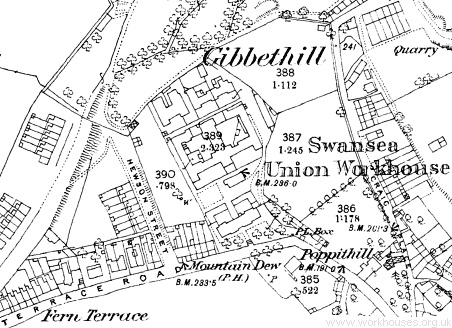
Swansea workhouse site, 1879.
An entrance and administrative block lay to the south. To its rear, the main building had a double-couryard layout.
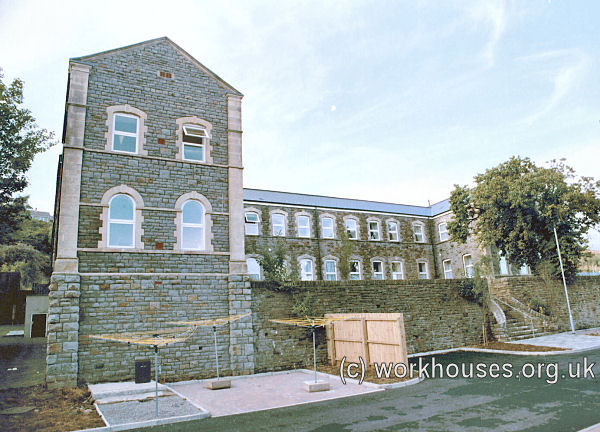
Swansea workhouse main building from the south-west, 2000.
© Peter Higginbotham.
Poor Law Board Inspector, Mr. J.T.Graves, visited the workhouse in April 1866. His report noted some deficiencies in the care of the sick:
The workhouse buildings were extended to the north-east in 1884 at a cost of £30,000. By 1895, the workhouse could hold 584 inmates with 300 infirmary beds. A new entrance, receiving wards etc. were also erected on Terrace Road.
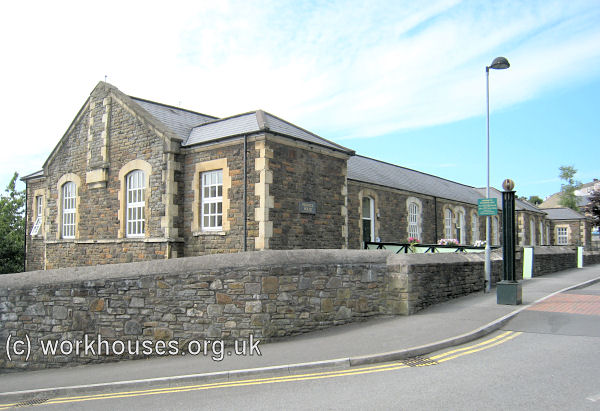
Swansea workhouse 1884 infirmary from the north-east, 2010.
© Peter Higginbotham.
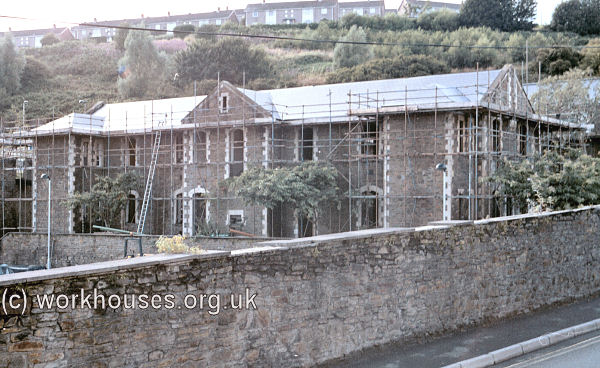
Swansea 1884 ward block from the south-east, 2000.
© Peter Higginbotham.
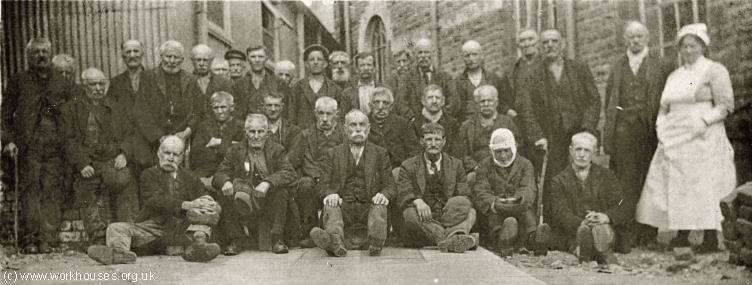
Swansea workhouse inmates, date unknown.
© Peter Higginbotham.
In 1902-3, several new buildings were erected at the south of the site, involving the demolition of some existing blocks. The most significant addition was a large female infirmary. The scheme was designed by local architect Mr Herbert W Wills and cost over £17,000 to carry out. The new buildings were formally opened on 13 January 1904 by Mr F.H. Glyn Price. The enlarged workhouse layout is shown on the 1919 map below.
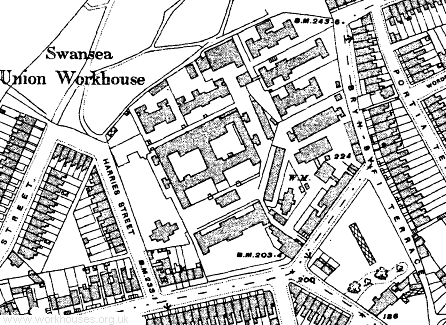
Swansea workhouse site, 1919.
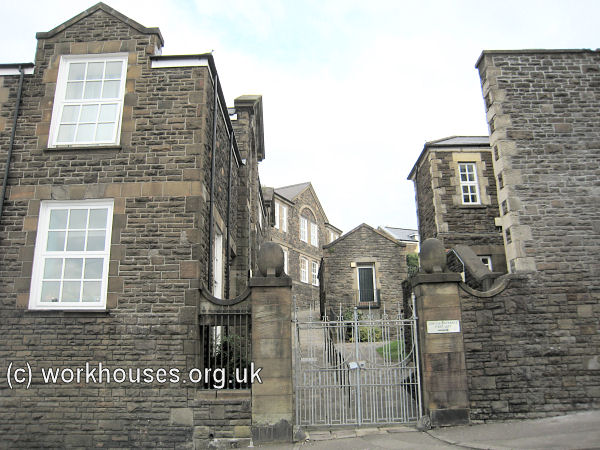
Swansea workhouse entrance gates, 2000.
© Peter Higginbotham.
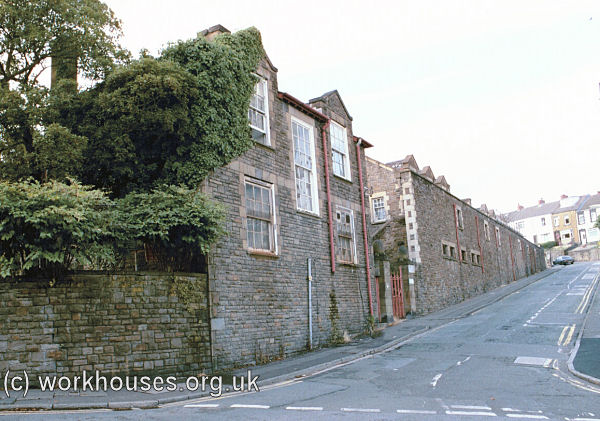
Swansea Terrace Road buildings from the south, 2000.
© Peter Higginbotham.
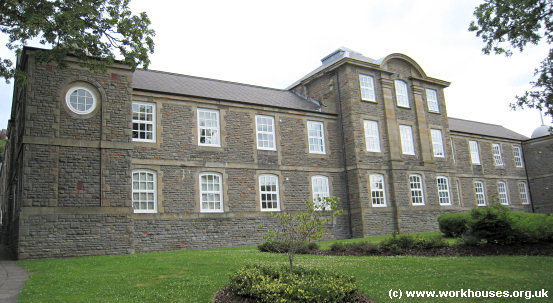
Swansea 1903 female infirmary from the south-west, 2000.
© Peter Higginbotham.
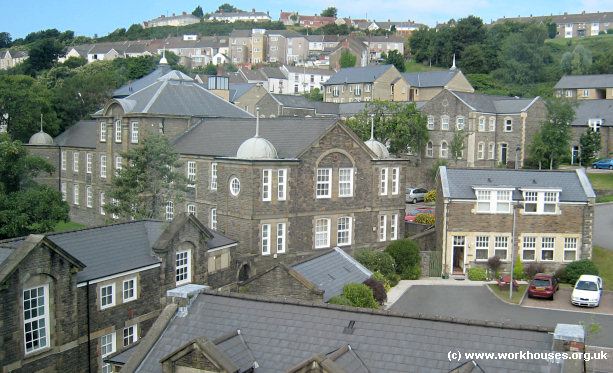
Swansea workhouse view from the south-east, 2010.
© Peter Higginbotham.
The workhouse later became known as Tawe Lodge, and then as Mount Pleasant Hospital. After its closure in 1995, the site was used a student accommodation. In 2000, the site was redeveloped with some of the old buildings being preserved and refurbished for residential use.
Cottage Homes, Cockett
In November 1877, the union opened a group of cottage homes at Cockett at a cost of £4,200. These were enlarged in 1879 and then comprised five plain stone buildings enclosing an area of ten acres and able to accommodate up to 120 children away from the workhouse. Although a few other unions had experimented with cottage homes schemes, Swansea's can probably claim to be the first in the poor law system that met the ideal of them being on a rural site that was completely separate from the workhouse.
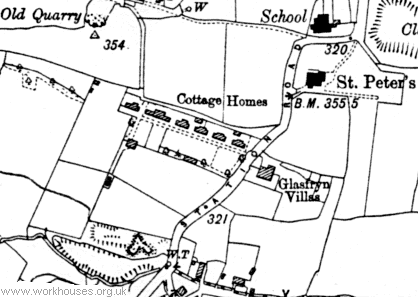
Swansea cottage homes site, 1921.
Beginning in 1900, boys from the homes spent several weeks at camp each summer alongside boys from the Swansea Boys' Industrial School.
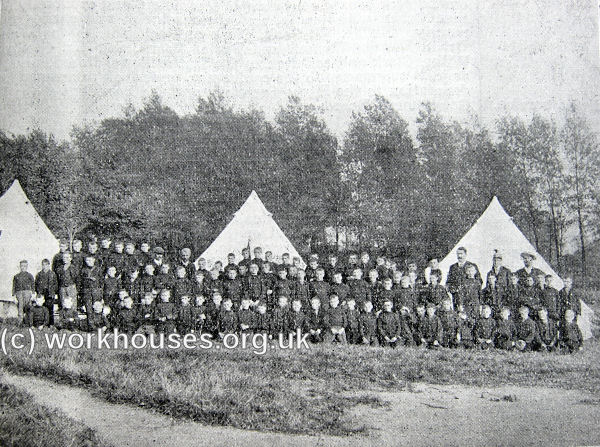
Swansea boys' camp, 1906. © Peter Higginbotham
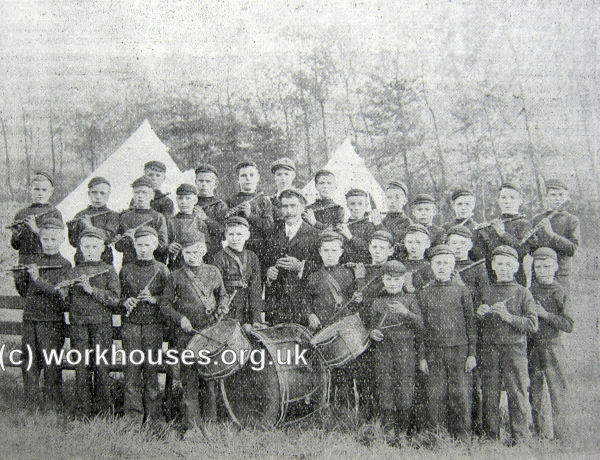
Swansea boys' camp band, 1906. © Peter Higginbotham
The homes have now been demolished.
Staff
Inmates
Records
Note: many repositories impose a closure period of up to 100 years for records identifying individuals. Before travelling a long distance, always check that the records you want to consult will be available.
- West Glamorgan Archive Service, County Hall, Oystermouth Road, Swansea SA1 3SN. Holdings include: Guardians' minute books (1849-51, 1860-1930, with gaps); Indoor relief book (1836-40); Deaths (1924); Creed register (1868-70, 1903-27); Punishment book (1855-80); Workhouse master's reports (1842-1914); School admissions/discharges - boys (1865-70); Cottage Homes Visiting Committee (1878-1904); Cottage Homes report books (1883-1950); etc.
- Ancestry UK
has a variety of workhouse records for the Swansea, Gower, Neath and Pontardawe Unions available online. Those for Swansea include: Workhouse Master's report and journal (1842-1914); Creed register (1903-14); Indoor relief book (1836-40); List of paupers (1872-95, with gaps); Births register (1866-1927); Register of deaths (1895-1920); Register of lunatics (1890-99); Punishment book (1855-80); Register of young persons (1865-70); School admissions/discharges - boys (1865-70); School attendance books (1876-7).
Bibliography
- Lewis, B. (2003) Swansea and the Workhouse (Swansea: West Glamorgan Archive Service)
- Grant, Raymond K (1988) On the Parish (Glamorgan Archive Service)
- NEW! Workhouses of Wales and the Welsh Borders. The story of the workhouse across the whole of Wales and the border counties of Cheshire, Gloucestershire, Herefordshire and Shropshire. More...
Links
- None.
Unless otherwise indicated, this page () is copyright Peter Higginbotham. Contents may not be reproduced without permission.


